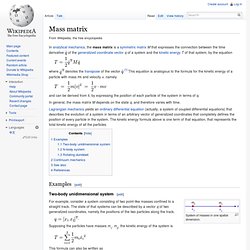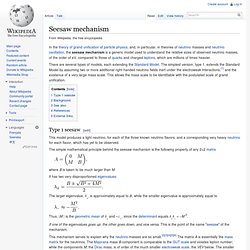

Artificial neural network. An artificial neural network is an interconnected group of nodes, akin to the vast network of neurons in a brain.

Here, each circular node represents an artificial neuron and an arrow represents a connection from the output of one neuron to the input of another. For example, a neural network for handwriting recognition is defined by a set of input neurons which may be activated by the pixels of an input image. After being weighted and transformed by a function (determined by the network's designer), the activations of these neurons are then passed on to other neurons. Neural network. 0511178.pdf (application/pdf Object) Mass matrix. Of the generalized coordinate vector q of a system and the kinetic energy T of that system, by the equation where denotes the transpose of the vector .[1] This equation is analogous to the formula for the kinetic energy of a particle with mass and velocity v, namely.

Seesaw mechanism. In the theory of grand unification of particle physics, and, in particular, in theories of neutrino masses and neutrino oscillation, the seesaw mechanism is a generic model used to understand the relative sizes of observed neutrino masses, of the order of eV, compared to those of quarks and charged leptons, which are millions of times heavier.

There are several types of models, each extending the Standard Model. The simplest version, type 1, extends the Standard Model by assuming two or more additional right-handed neutrino fields inert under the electroweak interactions,[1] and the existence of a very large mass scale. This allows the mass scale to be identifiable with the postulated scale of grand unification. Type 1 seesaw[edit]